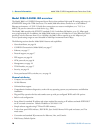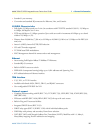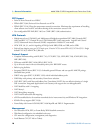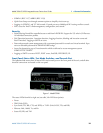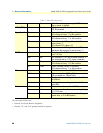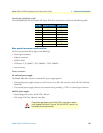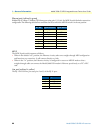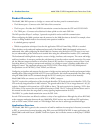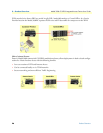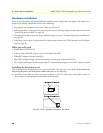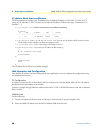
2 • Product Overview Model 3086 G.SHDSL Integrated Access Device User Guide
24 Product Overview
Product Overview
The Model 3086 IAD operates as a bridge or a router and has three ports for communication:
• The Ethernet port—Connects to the LAN side of the connection
• The Line port—Provides the G.SHDSL transmission connection between the CPE and CO DSL IAD
• The TDM port—Connects to local devices for data uplink over the main DSL link
The IAD provides all layer 2 and layer 3 protocols required for end-to-end-link communication.
When configuring the 3086, questions must be answered so the 3086 functions as desired. For example, when
a router or bridge module needs to be activated, some questions would be:
• Is a default gateway required?
• Which encapsulation technique is best for this application: PPPoA, Frame Relay, PPPoE or another?
These decisions can be made and implemented more easily if the Model 3086’s fundamental architecture is
understood. Also, while configuring the Model 3086 via a browser using the built-in HTTP server is very intui
-
tive, an understanding of the architecture is essential when using the command-line interface (CLI) commands.
The fundamental building blocks comprise a router or bridge, interfaces, and transports. The router and bridge
each have interfaces. A transport provides the path between an interface and an external connection. For exam
-
ple, the Ethernet transport attaches to an Internet Protocol (IP) interface. A transport consists of layer 2 and
everything below it. Creating a transport and attaching it to a bridge or router’s interface enables data to be
bridged or routed. The supported transports are PPPoA, PPPoE, Frame Relay, RFC 1483 (Multiprotocol
Encapsulation over ATM AAL5), IPoA, PPPoH, and Ethernet.
Configuring an interface and transport for the router or bridge requires naming the interface and transport before
attaching them. When using the built-in HTTP server web browser, this is done automatically. But when config
-
uring the Model 3086 via CLI commands through the RS-232 control port, it must be done manually.
Model 3086 IADs can connect over an ATM PVC or HDLC transport.
The PVC requires the configuration of the virtual path identifier (VPI) and virtual circuit identifier (VCI). The
VPI can be any integer between 0–4095 inclusive. The general rule for the VCI is an integer between 1–65,535
inclusive. Examples in this manual use a VCI of 600 or above. The main restriction in choosing a VCI is that
VCIs below 32 are reserved for such predefined functions as ILMI. The VCI values of 600 and above used in
this manual are also above the range used by many signaling implementations for SVCs.
The HDLC is a packet-based transmission across the DSL Link.
Several ATM connections are offered to address a variety of user applications. Although they all use RFC1483
as the transport mechanism between the two 3086 IADs, WAN services may use different PPP applications,
such as PPPoE routed, PPPoA routed, or PPPoA bridged. Each one has its advantages and disadvantages.
Applications Overview
The Model 3086 IAD is geared to the connection of small to medium size enterprises in Internet (connection
to ISP), or connection of remote branches using DSL access and IP/FR/ATM/PPP. In most applications, the
Model 3086 works with Patton’s 3096RC ForeFront System, but it will also connect to third-party G.SHDSL
devices.



